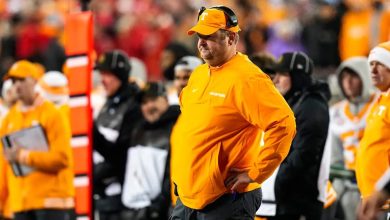Patty Gasso, after breaking the college softball attendance record, is reconsidering hosting a Sooners softball game at Oklahoma’s football stadium, sparking discussions about potential new venue plans.

Patty Gasso, one of the most celebrated figures in college softball, recently made headlines by leading the Oklahoma Sooners to set a new NCAA college softball attendance record. This remarkable achievement not only underscores the popularity of Oklahoma softball but also highlights the growing interest in collegiate softball at large. Following this historic milestone, Gasso has begun to reconsider her initial plans about hosting a Sooners softball game at Oklahoma’s renowned football stadium, a move that would symbolize the sport’s rising prominence and the program’s ambitious vision of expanding its reach. This reconsideration has ignited widespread discussions among fans, university officials, athletics administrators, and media outlets about the logistical challenges, strategic benefits, and cultural significance of hosting softball games in a large-scale venue traditionally reserved for football.
Background: Patty Gasso and Oklahoma Softball’s Rise
Patty Gasso has built Oklahoma softball into a powerhouse over the past two decades. Since taking over the program in 1995, Gasso has transformed the Sooners into a national dynasty, securing multiple national championships, developing top-tier talent, and cultivating a passionate fanbase. Her innovative coaching, emphasis on team culture, and relentless pursuit of excellence have elevated Oklahoma softball’s profile, making it one of the most popular and successful programs in college sports.
The recent attendance record, broken during a game at the OU Softball Complex, reflects the sport’s rapid growth in popularity, especially in Oklahoma where the team enjoys immense local support. The game drew an unprecedented number of spectators—surpassing previous NCAA records—highlighting the sport’s expanding national reach and the community’s fervent enthusiasm. This milestone not only celebrates the program’s success but also emphasizes the potential for larger venues and innovative event ideas to further capitalize on the sport’s momentum.
The Significance of the Attendance Record
Breaking the NCAA college softball attendance record is a landmark achievement that signifies more than just numbers. It symbolizes a cultural shift, where college softball is gaining mainstream attention, media coverage, and fan engagement comparable to other major sports. It reflects the passion of Oklahoma fans and the sport’s increasing appeal nationwide. The record-breaking game served as a milestone that demonstrated the potential for large-scale events beyond traditional venues.
This achievement has prompted discussions about how to leverage this momentum. Hosting a game in Oklahoma’s football stadium, Gaylord Family Oklahoma Memorial Stadium, which seats over 80,000 spectators, could be a historic and symbolic move. It would elevate the profile of softball, demonstrate the sport’s cultural significance, and provide an unparalleled experience for players and fans alike. The idea of filling a football stadium for a softball game symbolizes the sport’s growth and the ambitions of the Oklahoma program to push boundaries and set new standards.
Initial Plans and Reconsideration
Initially, there was enthusiasm within the Oklahoma softball community and university administration about hosting a game at the football stadium. The concept was to create a marquee event, akin to the “Pink Out” or “Pink Game” traditions in college sports, where the game could be promoted as a once-in-a-lifetime spectacle. Such an event would attract media attention, boost ticket sales, and serve as a celebration of softball’s ascendancy.
However, as plans progressed, Patty Gasso and the athletic department began to reconsider this idea. Several factors contributed to her re-evaluation:
Logistical Challenges: Hosting a softball game in a football stadium involves complex logistics, including field setup, seating arrangements, equipment transportation, and ensuring the safety and comfort of players and fans. The dimensions of a football field differ from a softball field, necessitating significant modifications, such as installing a temporary softball diamond, proper lighting, and other infrastructure.
Field Conditions and Surface Concerns: Football stadiums have turf or grass surfaces designed for football play, which may not be suitable for softball. Ensuring a high-quality, safe, and regulation-compliant playing surface would require substantial planning, investment, and time.
Scheduling Conflicts: Coordinating a game in the stadium around football schedules, other sporting events, and university activities could pose challenges, especially during a busy athletic calendar.
Cost Considerations: The financial implications of transforming a football stadium into a softball venue for a single game could be significant. This includes costs for equipment, staffing, security, maintenance, and potential revenue impacts.
Player Experience and Safety: Gasso and her coaching staff are committed to providing the best experience for the athletes. Concerns about the quality of the playing surface, visibility, and fan experience in a large, multi-purpose venue may have contributed to her cautious approach.
Despite these challenges, the idea of hosting a game in the stadium remains compelling, both symbolically and practically. The decision to reconsider does not detract from the achievement but underscores a thoughtful and strategic approach to balancing ambition with feasibility.
Broader Context: The Growth of College Softball
Understanding Gasso’s reconsideration requires appreciating the broader growth of college softball. The sport has seen exponential expansion over the past decade, driven by increased youth participation, media coverage, and institutional support. The NCAA Softball Tournament, culminating in the Women’s College World Series (WCWS), garners significant viewership, and the sport’s athletes have become role models for young fans.
This growth has inspired innovations such as hosting games in larger venues, creating special event days, and increasing attendance expectations. The idea of playing in a football stadium aligns with this trend, aiming to elevate softball’s profile and attract new audiences. For example, other sports, such as baseball, have successfully hosted games in NFL stadiums or large arenas, setting precedents for softball.
In Oklahoma, softball has become a cultural phenomenon, with community support rivaling that of football and basketball. The success of the program under Gasso has helped foster a sense of pride and identity, making the prospect of a stadium event not just a logistical challenge but a cultural milestone.
Logistical and Operational Considerations
If the decision is made to pursue the stadium-hosted game, numerous logistical considerations must be addressed:
Field Setup: Installing a regulation softball field within a football stadium requires precision. The dimensions of a softball field include a 60-foot base path and a 43-foot pitching distance for women’s softball, which are vastly different from football field measurements. Temporary structures, turf modifications, and safety measures would be necessary.
Surface and Safety: The playing surface must meet NCAA standards, ensuring player safety and consistent gameplay. This might involve installing a specialized turf or portable field components designed for softball.
Spectator Experience: Seating arrangements would need adjustments to provide optimal viewing angles, accessibility, and amenities such as concessions, restrooms, and merchandise stands.
Media and Broadcast: The event could be designed as a media spectacle, with broadcast arrangements, commentary booths, and enhanced promotional efforts.
Security and Crowd Management: Large crowds require detailed security plans, crowd control measures, and coordination with local law enforcement.
Revenue and Ticketing: Strategically priced tickets, pre-event marketing, and VIP packages could maximize revenue and attendance.
Weather and Environmental Factors: Oklahoma weather, especially in spring, can be unpredictable. Contingency plans for rain or storms would be vital.
Player Preparation: Training and acclimatization sessions would ensure players are comfortable and confident on the field.
Potential Benefits of Hosting the Game at a Stadium
Despite the logistical hurdles, hosting a softball game in a football stadium offers numerous benefits:
Elevating the Sport: Such a high-profile event can serve as a showcase for college softball, attracting media coverage, sponsorships, and new fans.
Inspiring Young Athletes: Seeing softball played in a massive venue can inspire young girls and aspiring athletes, fostering the next generation of players.
Community Engagement: A stadium event can unite communities, bringing together students, alumni, local residents, and national fans.
Program Prestige: It underscores Oklahoma’s commitment to innovation and excellence, strengthening the program’s brand.
Revenue Opportunities: Larger venues can generate increased ticket sales, merchandise, and concessions.
Media Exposure: The event could be broadcast nationally, further elevating the sport’s profile.
Cultural Impact: It positions Oklahoma softball as a trailblazer, setting a precedent for other programs considering similar initiatives.
Potential Challenges and Criticisms
While the benefits are compelling, there are challenges and criticisms to consider:
Cost and Resource Allocation: Critics may question whether the investment produces sufficient returns or distracts from other program priorities.
Player Safety and Experience: Concerns about the playing surface quality and player comfort could overshadow the event’s spectacle.
Logistical Complexity: The intricacies involved may lead to delays or unforeseen issues, potentially compromising the event’s success.
Environmental Impact: Large-scale events in stadiums can have environmental considerations, including waste management and energy use.
Tradition and Authenticity: Some purists might argue that softball’s appeal lies in its intimate, community-focused venues, and playing in a massive stadium could alter the sport’s character.
Patty Gasso’s Leadership and Vision
Patty Gasso’s leadership is central to this decision-making process. Known for her innovative approach and strategic vision, Gasso carefully weighs the risks and rewards of ambitious projects. Her recent reconsideration reflects her commitment to balancing tradition, safety, and growth opportunities.
Gasso’s leadership emphasizes that the ultimate goal is to promote and grow softball, providing an exciting and memorable experience for players and fans. Her cautious optimism suggests she recognizes the potential of a stadium event but also understands the importance of doing it right. This measured approach ensures that any decision aligns with the program’s long-term vision and values.
The Future of College Softball Events
Looking ahead, the possibility of hosting softball games in NFL or college football stadiums signals a new era for the sport. As interest continues to grow, innovative large-scale events could become a staple, offering fans a once-in-a-lifetime experience while elevating the sport’s stature nationally.
Oklahoma’s prospective stadium game under Gasso’s leadership could serve as a blueprint for other programs seeking to expand their reach. It might inspire partnerships with local communities, media companies, and sponsors to create comprehensive event experiences that redefine college softball.
This movement also aligns with broader trends in sports marketing, where creating memorable, shareable moments in iconic venues drives engagement and revenue. The success of such initiatives depends on meticulous planning, community support, and a clear vision for the sport’s future.
Patty Gasso’s reconsideration of hosting a Sooners softball game at Oklahoma’s football stadium is a reflection of the sport’s exponential growth, the program’s innovative spirit, and the desire to elevate college softball to new heights. While logistical and operational challenges exist, the potential benefits—heightened visibility, inspiring fans and athletes, and cementing Oklahoma’s leadership in college softball—are substantial. Gasso’s thoughtful approach demonstrates her commitment to ensuring that any such event embodies excellence, safety, and the sport’s core values. As the Oklahoma softball program continues to push boundaries and set new standards, this potential stadium event symbolizes both the sport’s bright future and the unwavering leadership of one of college softball’s most influential figures.









